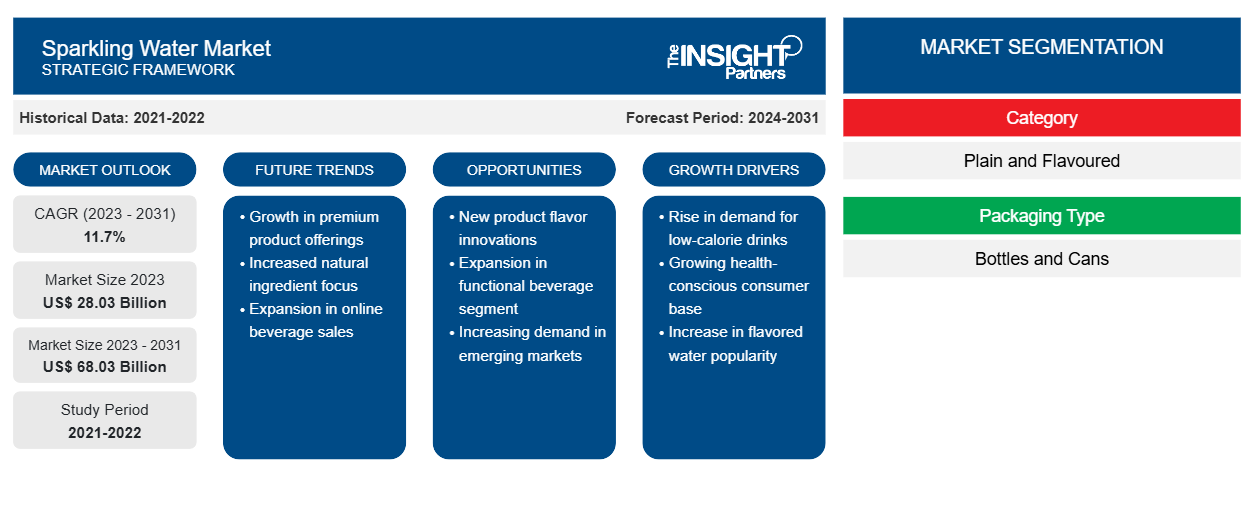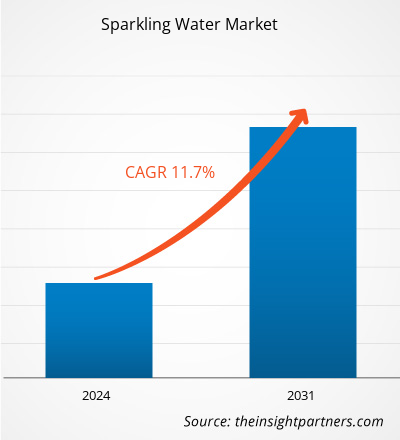Sparkling Water Market Growth, Analysis, and Forecast by 2031
Historic Data: 2021-2022 | Base Year: 2023 | Forecast Period: 2024-2031Sparkling Water Market Size and Forecast (2021–2031), Global and Regional Share, Trend, and Growth Opportunity Analysis Report Coverage: By Category (Plain and Flavoured), Packaging Type (Bottles and Cans), Distribution Channel (Supermarkets and Hypermarkets, Convenience Stores, Online Retail, and Others), and Geography
- Report Date : Mar 2026
- Report Code : TIPRE00015123
- Category : Food and Beverages
- Status : Data Released
- Available Report Formats :


- No. of Pages : 150
The sparkling water market size is projected to reach US$ 68.03 billion by 2031 from US$ 28.03 billion in 2023. The market is expected to register a CAGR of 11.7% in 2023–2031. The growing popularity of sparkling water among millennials is likely to remain a key sparkling water market trends.
Sparkling Water Market Analysis
Various health benefits associated with sparkling water are boosting the growth of the sparkling water market. With the growing trend of adopting a healthy lifestyle among all age groups, consumers are progressively switching to healthy and innovative drinks, including sparkling water, especially as an alternative to sodas and sugary carbonated beverages. This is increasing the sparkling water market size. According to Nestlé, a Switzerland-based food and beverages company, ~64% of consumers prefer functional beverages with no added calories. In addition, most young age consumers are increasingly opting for sparkling water over plain water, mainly due to their preference for flavours.
Sparkling Water Market Overview
Sparkling water is one of the preferred alternatives for soft drinks such as soda and juices. Sparkling water is produced when water is infused with carbon dioxide under pressure which makes it drink similar to soft drinks with less calories. It comes in plain and flavoured categories with added sweeteners and sugar. Sparkling water keeps a person hydrated and provides weight management benefits. Research also states that sparkling water improves digestion and helps to relieve constipation. Currently, sparkling water is gaining popularity owing to its health benefits and less calorie content compared to other soft drinks.
Customize This Report To Suit Your Requirement
You will get customization on any report - free of charge - including parts of this report, or country-level analysis, Excel Data pack, as well as avail great offers and discounts for start-ups & universities
Sparkling Water Market: Strategic Insights

-
Get Top Key Market Trends of this report.This FREE sample will include data analysis, ranging from market trends to estimates and forecasts.
Sparkling Water Market Drivers and Opportunities
Increasing Number of New Product Launches
Manufacturers are launching innovative beverage varieties to reduce levels of added sugar and improve the overall consumer experience. In March 2021, Nestle's US Perrier brand announced Energize, caffeinated sparkling water. With this, the company has presented its initial line of carbonated energy beverages. Further, in May 2021, PepsiCo launched Soulboost, an enhanced sparkling water beverage made with real juice and functional ingredients. Also, to satisfy the growing demands, manufacturers are trying to launch new product variants with caffeine in it. Therefore, the continuous product innovations by key sparkling water companies are grabbing the attention of consumers, thus propelling the sparkling water market growth.
Surge in At-Home Consumption
During the initial months of the COVID-19 pandemic, most offices and public places were closed, which led to a substantial drop in the commercial demand for sparkling water. However, widespread home isolation orders due to COVID-19 have driven the demand for various types of bottled water, including sparkling water, among households. The change in consumers’ shopping behavior is also one of the significant factors driving sales through the online channel. Thus, a surge in at-home consumption is creating lucrative opportunities for the growth of the sparkling water market players.
Sparkling Water Market Report Segmentation Analysis
Key segments that contributed to the derivation of the sparkling water market analysis are category, packaging type, and distribution channel.
- Based on category, the sparkling water market is segmented into plain and flavoured. The flavoured segment held a larger market share in 2023.
- By packaging type, the market is segmented into bottles and cans. The cans segment held a larger share of the market in 2023.
- In terms of distribution channel, the market is segmented into supermarkets and hypermarkets, convenience stores, online retail, others. The supermarkets and hypermarkets segment held a larger share of the market in 2023.
Sparkling Water Market Share Analysis by Geography
The geographic scope of the sparkling water market report is mainly divided into five regions: North America, Asia Pacific, Europe, Middle East & Africa, and South & Central America.
The Asia Pacific region holds a larger share of the global market. North America is also one of the major contributors in the global sparkling water market growth. In North America, the sparkling water market is currently in the growth phase and experiencing exponential growth. With the growing trend of leading a healthy lifestyle among all age groups, the population of North America is gradually shifting towards healthy and innovative drinks, including sparkling water. The market is likely to be driven by rising consumer preference for sparkling water over soda water and sugary carbonated drinks.
Sparkling Water Market Regional Insights
The regional trends and factors influencing the Sparkling Water Market throughout the forecast period have been thoroughly explained by the analysts at The Insight Partners. This section also discusses Sparkling Water Market segments and geography across North America, Europe, Asia Pacific, Middle East and Africa, and South and Central America.
Sparkling Water Market Report Scope
| Report Attribute | Details |
|---|---|
| Market size in 2023 | US$ 28.03 Billion |
| Market Size by 2031 | US$ 68.03 Billion |
| Global CAGR (2023 - 2031) | 11.7% |
| Historical Data | 2021-2022 |
| Forecast period | 2024-2031 |
| Segments Covered |
By Category
|
| Regions and Countries Covered |
North America
|
| Market leaders and key company profiles |
|
Sparkling Water Market Players Density: Understanding Its Impact on Business Dynamics
The Sparkling Water Market is growing rapidly, driven by increasing end-user demand due to factors such as evolving consumer preferences, technological advancements, and greater awareness of the product's benefits. As demand rises, businesses are expanding their offerings, innovating to meet consumer needs, and capitalizing on emerging trends, which further fuels market growth.

- Get the Sparkling Water Market top key players overview
Sparkling Water Market News and Recent Developments
The sparkling water market is evaluated by gathering qualitative and quantitative data post primary and secondary research, which includes important corporate publications, association data, and databases. The following is a list of developments in the market for sparkling water and strategies:
- PepsiCo, the leading-edge food and beverage company, just launched its latest innovation, soulboost, a sparkling water beverage with a splash of real jsuice and functional ingredients. Soulboost captures the fun of a fruity drink through a light, guilt-free sparkling water refreshment. Its two varieties, Lift and Ease, offer four delicious flavors and just 10 to 20 calories per 12 oz can. (Source: Cision US Inc, Company Website/News Release/2021)
- Perrier, a brand of Nestlé SA, Vevey, Switzerland, expanded into the carbonated energy beverage market with its latest release: Perrier Energize. The effervescent mineral water from France sources its caffeine from organic green coffee and yerba mate extracts. (Source: BNP Media., Company Website/ Articles /2021)
- Keurig Dr Pepper acquired Chicago-based caffeinated sparkling water brand Limitless. Terms of the deal were not disclosed. (Source: Industry Dive, Company Website/ News/2020)
Sparkling Water Market Report Coverage and Deliverables
The “Sparkling Water Market Size and Forecast (2021–2031)” report provides a detailed analysis of the market covering below areas:
- Market size and forecast at global, regional, and country levels for all the key market segments covered under the scope
- Market dynamics such as drivers, restraints, and key opportunities
- Key future trends
- Detailed Porter’s Five Forces and SWOT analysis
- Global and regional market analysis covering key market trends, major players, regulations, and recent market developments
- Industry landscape and competition analysis covering market concentration, heat map analysis, prominent players, and recent developments
- Detailed company profiles
Habi is a seasoned Market Research Analyst with 8 years of experience specializing in the Chemicals and Materials sector, with additional expertise in the Food & Beverages and Consumer Goods industries. He is a Chemical Engineer from Vishwakarma Institute of Technology (VIT) and has developed deep domain knowledge across industrial and specialty chemicals, paints and coatings, paper and packaging, lubricants, and consumer products. Habi’s core competencies include market sizing and forecasting, competitive benchmarking, trend analysis, client engagement, report writing, and team coordination—making him adept at delivering actionable insights and supporting strategic decision-making.
- Historical Analysis (2 Years), Base Year, Forecast (7 Years) with CAGR
- PEST and SWOT Analysis
- Market Size Value / Volume - Global, Regional, Country
- Industry and Competitive Landscape
- Excel Dataset
Related Reports
Testimonials
The Insight Partners' SCADA System Market report is comprehensive, with valuable insights on current trends and future forecasts. The team was highly professional, responsive, and supportive throughout. We are very satisfied and highly recommend their services.
RAN KEDEM Partner, Reali Technologies LTDsI requested a report on a very specific software market and the team produced the report in a few days. The information was very relevant and well presented. I then requested some changes and additions to the report. The team was again very responsive and I got the final report in less than a week.
JEAN-HERVE JENN Chairman, Future AnalyticaWe worked with The Insight Partners for an important market study and forecast. They gave us clear insights into opportunities and risks, which helped shape our plans. Their research was easy to use and based on solid data. It helped us make smart, confident decisions. We highly recommend them.
PIYUSH NAGPAL Sr. Vice President, High Beam GlobalThe Insight Partners delivered insightful, well-structured market research with strong domain expertise. Their team was professional and responsive throughout. The user-friendly website made accessing industry reports seamless. We highly recommend them for reliable, high-quality research services
YUKIHIKO ADACHI CEO, Deep Blue, LLC.This is the first time I have purchased a market report from The Insight Partners.While I was unsure at first, I visited their web site and felt more comfortable to take the risk and purchase a market report.I am completely satisfied with the quality of the report and customer service. I had several questions and comments with the initial report, but after a couple of dialogs over email with their analyst I believe I have a report that I can use as input to our strategic planning process.Thank you so much for taking the extra time and making this a positive experience.I will definitely recommend your service to others and you will be my first call when we need further market data.
JOHN SUZUKI President and Chief Executive Officer, Board Director, BK TechnologiesI wish to appreciate your support and the professionalism you displayed in the course of attending to my request for information regarding to infectious disease IVD market in Nigeria. I appreciate your patience, your guidance, and the fact that you were willing to offer a discount, which eventually made it possible for us to close a deal. I look forward to engaging The Insight Partners in the future, all thanks to the impression you have created in me as a result of this first encounter.
DR CHIJIOKE ONYIA MANAGING DIRECTOR, PineCrest Healthcare Ltd.Reason to Buy
- Informed Decision-Making
- Understanding Market Dynamics
- Competitive Analysis
- Identifying Emerging Markets
- Customer Insights
- Market Forecasts
- Risk Mitigation
- Boosting Operational Efficiency
- Strategic Planning
- Investment Justification
- Tracking Industry Innovations
- Aligning with Regulatory Trends




















 Get Free Sample For
Get Free Sample For